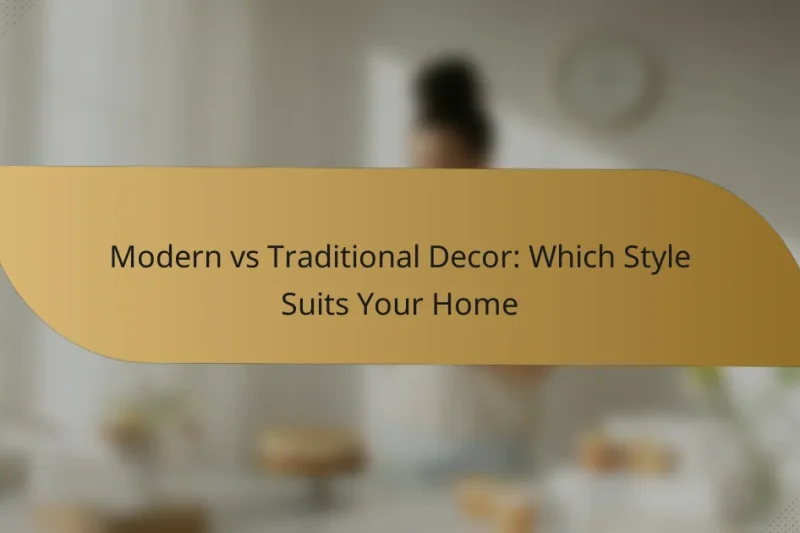Identifying your personal decor style is a journey of self-discovery that involves understanding your tastes, lifestyle, … Personal Decor Style: Identifying Your Unique PreferencesRead more
Home Decor Styles: Choosing the Right One
Choosing the right home decor style is crucial for creating a space that reflects your personality and enhances your living environment. With popular styles like Modern, Bohemian, Industrial, Farmhouse, and Scandinavian, each offers unique characteristics that can transform your home. By considering your preferences, architectural features, and budget, you can select a decor style that harmonizes with your lifestyle and creates an inviting atmosphere.
Transitional Decor: Balancing Old and New Styles
Transitional decor is all about striking a balance between vintage charm and modern sophistication, creating a … Transitional Decor: Balancing Old and New StylesRead more
Farmhouse Decor: Selecting for a Modern Aesthetic
Embracing modern farmhouse decor means harmonizing rustic charm with sleek contemporary design. By prioritizing simplicity, natural … Farmhouse Decor: Selecting for a Modern AestheticRead more
Bohemian and Minimalist Decor: Blending Styles in Small Spaces
Blending Bohemian and Minimalist decor in small spaces creates a unique harmony between vibrant eclecticism and … Bohemian and Minimalist Decor: Blending Styles in Small SpacesRead more
Rustic Decor: Tips for Urban Living
Bringing rustic decor into urban living spaces can transform your home into a cozy retreat that … Rustic Decor: Tips for Urban LivingRead more
Coastal Home Decor: Top 5 Styles for Buyers
Coastal home decor offers a delightful way to bring the essence of the beach into your … Coastal Home Decor: Top 5 Styles for BuyersRead more
Modern vs Traditional Decor: Which Style Suits Your Home
When it comes to home decor, modern and traditional styles present distinct design philosophies that cater … Modern vs Traditional Decor: Which Style Suits Your HomeRead more
What are the most popular home decor styles?
The most popular home decor styles include Modern, Bohemian, Industrial, Farmhouse, and Scandinavian. Each style has unique characteristics and can significantly influence the ambiance of a space, making it essential to choose one that aligns with your personal taste and lifestyle.
Modern style
Modern style emphasizes simplicity, clean lines, and a neutral color palette. It often incorporates materials like glass, steel, and concrete, focusing on functionality and minimalism.
To achieve a modern look, consider using furniture with sleek designs and avoiding excessive ornamentation. Key elements include open spaces and natural light, so large windows and uncluttered layouts are beneficial.
Bohemian style
Bohemian style is characterized by a mix of colors, patterns, and textures, creating a vibrant and eclectic atmosphere. This style often features vintage items, handmade crafts, and global influences.
To embrace Bohemian decor, layer textiles like rugs and cushions, and incorporate plants for a natural touch. Avoid rigid matching; instead, focus on personal expression and comfort.
Industrial style
Industrial style draws inspiration from warehouses and factories, showcasing raw materials like exposed brick, metal, and wood. This style often features an open layout with a rugged aesthetic.
To create an industrial look, consider using reclaimed materials and large, functional furniture. Keep the color scheme muted, with shades of gray, brown, and black, while adding pops of color through artwork or accessories.
Farmhouse style
Farmhouse style combines rustic charm with modern comfort, often featuring natural wood, vintage decor, and a cozy atmosphere. This style emphasizes practicality and warmth.
To achieve a farmhouse look, incorporate elements like shiplap walls, distressed furniture, and soft textiles. Use a neutral color palette with earthy tones to create a welcoming environment.
Scandinavian style
Scandinavian style is known for its simplicity, functionality, and connection to nature. It features light colors, natural materials, and a focus on minimalism.
To implement Scandinavian decor, choose furniture with clean lines and light wood finishes. Incorporate plenty of natural light and use soft textiles to create a cozy yet uncluttered space.
How to choose the right home decor style for your space?
Choosing the right home decor style involves understanding your preferences, the architectural features of your space, and your financial capacity. By aligning these elements, you can create a cohesive and inviting environment that reflects your personality.
Assess your personal taste
Your personal taste is the foundation of your home decor style. Consider what colors, patterns, and materials resonate with you. Look through design magazines, websites, or social media platforms like Pinterest to gather inspiration and identify styles that appeal to you.
Make a list of your favorite styles, such as modern, rustic, or eclectic, and note specific elements you love, like bold colors or minimalist designs. This will help you narrow down your choices and create a clear vision for your space.
Consider your space’s architecture
The architecture of your home plays a crucial role in determining the appropriate decor style. Pay attention to features like ceiling height, window size, and architectural details. For instance, a Victorian home may benefit from traditional decor, while a modern loft might suit a contemporary style.
Take measurements and visualize how different styles will complement or clash with existing elements. This consideration will ensure that your decor feels harmonious and enhances the overall aesthetic of your space.
Evaluate your budget
Your budget significantly influences your home decor choices. Determine how much you can realistically spend on furnishings, decor items, and renovations. A well-defined budget will help you prioritize essential purchases and avoid overspending.
Consider allocating funds for key pieces first, such as a sofa or dining table, and then fill in with accessories and smaller items. Remember that you can find stylish options at various price points, so explore thrift stores, online marketplaces, and sales to maximize your budget.
What are the key characteristics of each home decor style?
Each home decor style has distinct characteristics that define its aesthetic and functionality. Understanding these traits can help you choose a style that aligns with your personal taste and lifestyle needs.
Modern style attributes
Modern style is characterized by clean lines, minimalism, and a focus on functionality. It often features neutral color palettes, open spaces, and a mix of natural and industrial materials.
To achieve a modern look, consider incorporating furniture with sleek designs and avoiding excessive ornamentation. Popular choices include low-profile sofas, geometric shapes, and large windows that allow natural light to flow in.
Bohemian style attributes
Bohemian style embraces a carefree, eclectic vibe with a mix of colors, patterns, and textures. This style often includes vintage furniture, handmade items, and an array of textiles like rugs and throws.
To create a Bohemian space, layer different materials and incorporate plants for a natural touch. Don’t shy away from bold colors and unique accessories that reflect your personality and travels.
Industrial style attributes
Industrial style draws inspiration from warehouses and factories, featuring raw materials like exposed brick, metal, and wood. This style often includes open floor plans and a utilitarian approach to decor.
To achieve an industrial look, focus on large, functional furniture pieces and incorporate elements like metal light fixtures and reclaimed wood. Keep the color scheme muted, with grays, browns, and blacks dominating the palette.
Farmhouse style attributes
Farmhouse style is known for its cozy, rustic charm, often incorporating natural materials and a warm color palette. Key elements include wooden beams, shiplap walls, and vintage accessories.
To create a farmhouse aesthetic, use distressed furniture and soft textiles. Incorporating elements like a large dining table and open shelving can enhance the inviting atmosphere of the space.
Scandinavian style attributes
Scandinavian style emphasizes simplicity, functionality, and minimalism, often featuring light colors and natural materials. This style promotes a sense of calm and order through its clean lines and uncluttered spaces.
To achieve a Scandinavian look, focus on light wood furniture, neutral tones, and plenty of natural light. Incorporate cozy textiles like wool throws and cushions to add warmth without compromising the minimalist aesthetic.
What are the best color palettes for home decor styles?
The best color palettes for home decor styles depend on the aesthetic you want to achieve. Neutral tones, vibrant colors, and earthy shades each create distinct atmospheres that can enhance your living space.
Neutral tones for modern style
Neutral tones, such as whites, grays, and beiges, are ideal for modern home decor. These colors create a clean and sophisticated look, allowing for flexibility in furniture and accessory choices.
When using neutral palettes, consider adding texture through materials like wood, metal, or fabric to avoid a flat appearance. Accent pieces in darker shades can also provide contrast and depth.
Vibrant colors for bohemian style
Bohemian style thrives on vibrant colors, including rich reds, deep blues, and bright yellows. These hues can be mixed and matched freely, creating a lively and eclectic atmosphere.
To achieve a bohemian look, layer different patterns and textures alongside bold colors. Incorporate items like colorful rugs, patterned cushions, and unique artwork to enhance the overall vibe.
Earthy tones for farmhouse style
Earthy tones, such as browns, greens, and soft whites, are perfect for farmhouse decor. These colors evoke a sense of warmth and comfort, making spaces feel inviting and homey.
When decorating with earthy tones, focus on natural materials like wood and stone. Incorporate vintage or rustic elements, such as distressed furniture or handmade crafts, to complete the farmhouse aesthetic.
How to mix and match different home decor styles?
Mixing and matching home decor styles involves combining various design elements to create a cohesive look. Focus on harmonizing textures, colors, and standout pieces to achieve a balanced aesthetic.
Layering textures
Layering textures adds depth and interest to your space. Consider combining materials like wood, metal, fabric, and glass to create a rich sensory experience. For example, pair a soft wool throw with a sleek leather sofa and a rustic wooden coffee table.
Be mindful of the weight of each texture; lighter fabrics can soften heavier materials. Aim for a mix of smooth, rough, shiny, and matte finishes to keep the eye engaged.
Balancing colors
Balancing colors is crucial when mixing decor styles. Start with a neutral base, then introduce accent colors that complement each other. A common approach is the 60-30-10 rule: 60% of the room should be a dominant color, 30% a secondary color, and 10% an accent color.
Use a color wheel to find harmonious combinations. For instance, if your primary color is blue, consider adding shades of green and a pop of orange for contrast. Avoid overwhelming the space with too many bold colors.
Incorporating statement pieces
Statement pieces serve as focal points in your decor and can bridge different styles. Choose one or two standout items, such as an oversized artwork or a unique piece of furniture, to anchor your design.
Ensure that these pieces resonate with the overall theme of the room while still standing out. For example, a vintage chandelier can complement modern furnishings, creating an eclectic yet cohesive look. Avoid cluttering the space with too many statement items, as this can detract from their impact.






